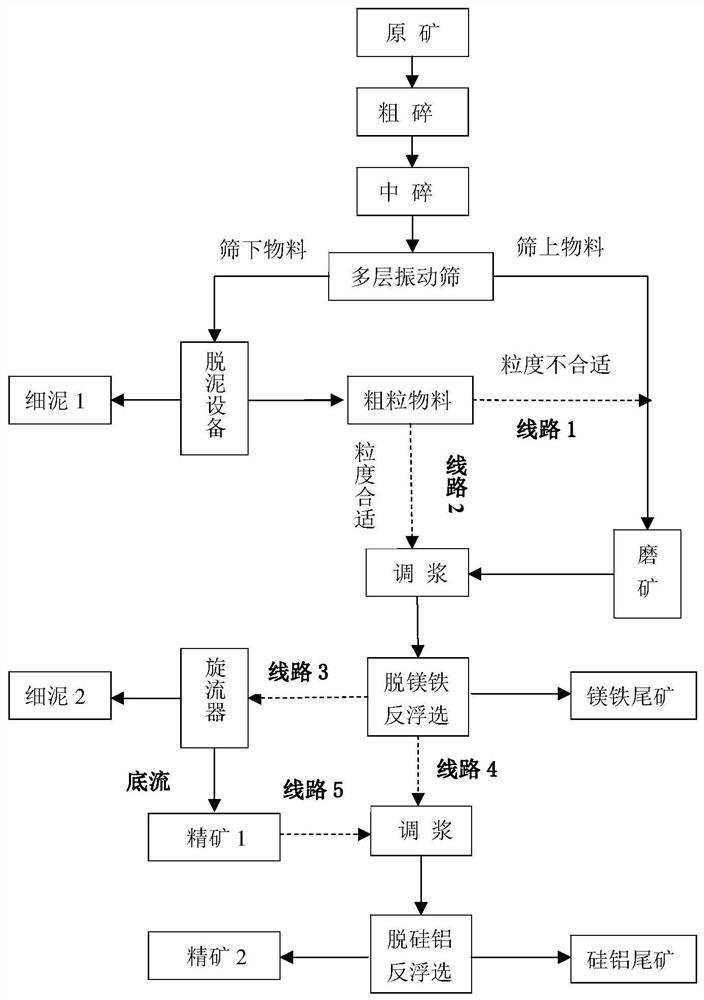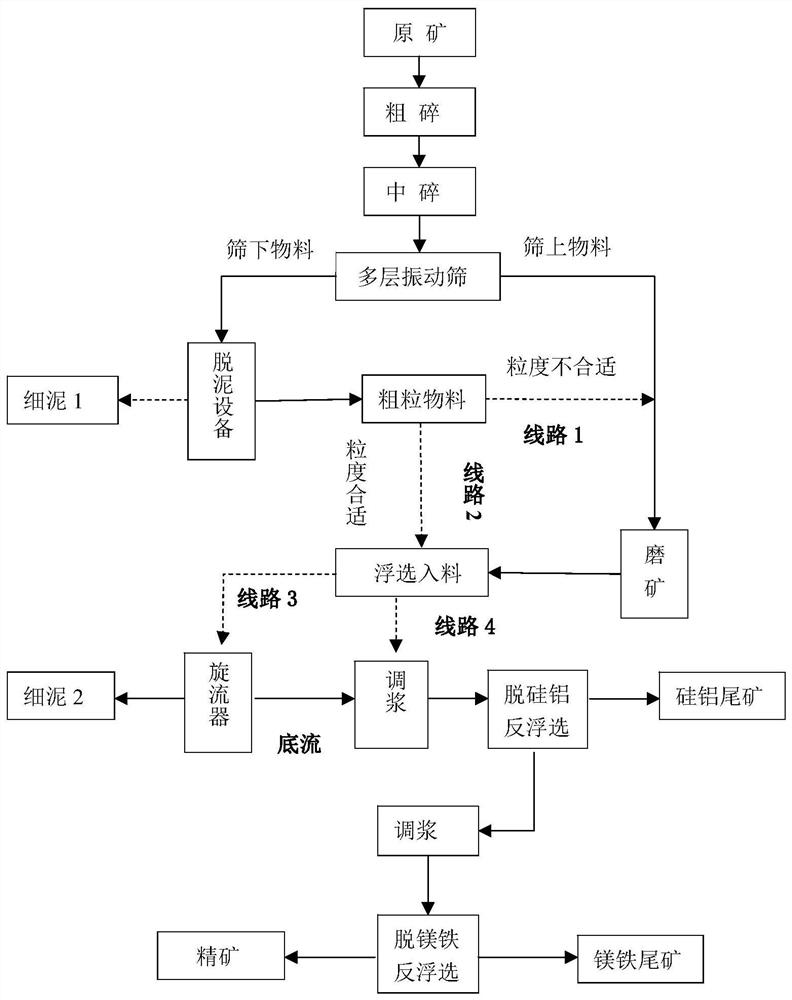Desliming double-reverse flotation method for reducing impurity elements of phosphorite
An impurity element, double-reverse flotation technology, applied in flotation, chemical instruments and methods, wet separation, etc., can solve the problems of difficult promotion, poor ore adaptability, low removal efficiency of iron, aluminum and silicon, etc. It has great application prospects, high degree of foam mineralization, and significant positive interaction.
- Summary
- Abstract
- Description
- Claims
- Application Information
AI Technical Summary
Problems solved by technology
Method used
Image
Examples
Embodiment 1
[0073] Example 1, a desliming double reverse flotation method for reducing impurity elements in phosphate rock:
[0074] The selected raw ore is a collophosite in Guizhou. The impurity elements mainly exist in clay minerals such as dolomite, muscovite, and kaolinite, pyrite, and a small amount of quartz and chalcedony. The main chemical element analysis result is 29.5% P 2 o 5 , 1.5% MgO, 1.6% Fe 2 o 3 , 3% Al 2 o 3 , 12% SiO 2 At present, the concentrator adopts a single reverse flotation magnesium removal process. Considering that the raw ore will be diluted in the later stage and impurity elements will increase, the desliming double reverse flotation method based on plan A is more suitable for this type of ore, such as image 3 As shown, it specifically includes the following steps:
[0075] (1) Crushing and desliming section: the phosphate rock is crushed to less than 20mm through coarse crushing and secondary crushing, and then the material with a particle size of ...
Embodiment 2
[0079] Example 2, a desliming double reverse flotation method for reducing impurity elements in phosphate rock:
[0080] The selected raw ore is a collophosite in Guizhou. The impurity elements mainly exist in clay minerals such as dolomite, muscovite, and kaolinite, pyrite, and a small amount of quartz and chalcedony. The main chemical element analysis result is 29.5% P 2 o 5 , 1.5% MgO, 1.6% Fe 2 o 3 , 3% Al 2 o 3 , 12%SiO2 2 At present, the concentrator adopts a single reverse flotation magnesium removal process. Considering that the raw ore will be diluted in the later stage and impurity elements will increase, the desliming double reverse flotation method based on plan A is more suitable for this type of ore, such as Figure 4 As shown, it specifically includes the following steps:
[0081] (1) Crushing and desliming section: the phosphate rock is crushed to less than 20mm through coarse crushing and medium crushing, and then the material with a particle size of le...
Embodiment 3
[0085] Example 3, a desliming double reverse flotation method for reducing impurity elements in phosphate rock:
[0086] The selected raw ore is a local colloidal phosphate rock, and its impurity elements mainly exist in clay minerals such as dolomite, mica, kaolinite, potassium feldspar, pyrrhotite, limonite, and a small amount of quartz and chalcedony. The main chemical element analysis result is 27% P 2 o 5 , 1.7% MgO, 1.4% Fe 2 o 3 , 4.5% Al 2 o 3 , 13.6 %SiO2 2 , using its desliming double reverse flotation method in Scheme A, such as Figure 5 As shown, it specifically includes the following steps:
[0087] (1) Crushing and desliming section: the phosphate rock is crushed to below 15mm through coarse crushing and secondary crushing, and then the materials with a particle size below 1mm are screened out through a multi-layer vibrating wet screen. The material passes through the hydrocyclone group, and the final overflow material is mainly -38 micron fine mud produ...
PUM
| Property | Measurement | Unit |
|---|---|---|
| hardness | aaaaa | aaaaa |
Abstract
Description
Claims
Application Information
 Login to View More
Login to View More - R&D Engineer
- R&D Manager
- IP Professional
- Industry Leading Data Capabilities
- Powerful AI technology
- Patent DNA Extraction
Browse by: Latest US Patents, China's latest patents, Technical Efficacy Thesaurus, Application Domain, Technology Topic, Popular Technical Reports.
© 2024 PatSnap. All rights reserved.Legal|Privacy policy|Modern Slavery Act Transparency Statement|Sitemap|About US| Contact US: help@patsnap.com










